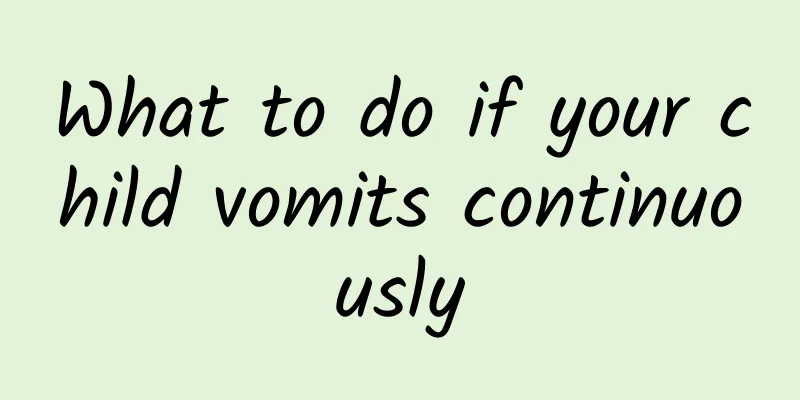What to do if your child vomits continuously

|
If a child vomits continuously, parents must pay attention, because this may be a respiratory infection. For example, upper respiratory tract infection or gastrointestinal disease may cause continuous vomiting. Food poisoning may also cause such a phenomenon. At this time, you must go to the hospital for examination in time. If the condition is serious, some drugs should be used to treat it. What to do if your child vomits continuously? When your child vomits due to upper respiratory tract infection, gastrointestinal disease, inappropriate food, etc., let the child sit up and tilt his head to one side to prevent vomitus from entering the trachea. Pay attention to the vomiting situation, the relationship between vomiting and diet and coughing, the number of vomiting, the vomited stomach contents, etc. After vomiting, rinse your mouth with warm water to clean your mouth and remove odor. Try to rest in bed and avoid changing your body position frequently, otherwise it will easily cause vomiting again. Babies can ensure their water supply by feeding them water frequently, cleaning their mouths, feeding them water frequently, and drinking small amounts frequently to prevent excessive water loss and dehydration. The water temperature should be hotter in winter and cooler in summer. Warm water can easily cause vomiting. Pay attention to your diet, don't eat too much, and try to eat small meals frequently. Do not eat greasy, spicy or sour foods to avoid irritating the stomach and intestines. After vomiting, you should first eat liquid or semi-liquid food, and gradually transition to a normal diet. In addition to emergency relief measures, we recommend that parents pay attention to several special situations. Cyclic vomiting often occurs in children aged 3 to 10 years old. The triggering causes are often irregular eating, excessive activity after eating, or mental stimulation. If cyclical vomiting does not cause serious complications, it is generally not dangerous and will gradually heal as the child grows older. Repeated severe vomiting, spitting out yellow water, and no improvement despite general care should prevent intestinal obstruction. If accompanied by other conditions such as fever, the details should be reported to the doctor. If you find that the vomitus is abnormal, you should bring it to your doctor so that the doctor can analyze the cause of the vomiting and deal with it promptly and correctly. Many infants occasionally vomit after feeding, which may be due to swallowing air. The nipple should be submerged during the next feeding to prevent them from swallowing air. After sucking, you can hold the child and pat his back gently to let the air out. Then lie on the right side with the upper body slightly raised. If the child often vomits after sucking milk but is generally normal, he may have pyloric spasm and should be given some antispasmodics under the guidance of a doctor. If there is still no improvement and the general nutritional condition is affected, you should prevent pyloric hypertrophy and ask a doctor to check. If a child vomits, parents should not scold the child. The most correct way is to fast for 4 hours and give the child a small amount of fruit juice, sugar and salt water or light tea. After observing the type of vomiting of the baby, provide care according to the above treatment plan. If the vomiting still cannot be relieved within 1-2 days, parents should take the child to see a doctor immediately to avoid serious conditions such as dehydration.How to use medicine for vomiting in children 1. Patients with severe vomiting must fast for 4 hours. Except for gastric perforation, gastric lavage can be performed with normal saline or 1-2% sodium bicarbonate solution. Be sure to lie on your side to prevent vomit from being inhaled into the trachea. 2. After vomiting stops or is alleviated, give a small amount of thick, slightly warm, easily digestible food or liquid diet such as rice soup. 3. Those with dehydration or electrolyte imbalance should be given fluid and electrolyte replacement as needed. If there is peripheral circulatory failure, it should be treated as circulatory failure. 4. Those with frequent vomiting should be given antiemetics and sedatives, such as Luminal, Metoclopramide suppositories, etc. Metoclopramide should be used with caution. 5. Antispasmodics, such as Solanum lysate, Atropine 654-2, Propane, 1-2% Procaine (1-2ml/year/time) can also be used according to the condition, but be careful that improper use may mask symptoms and is not conducive to a clear diagnosis. 6. Patients with intracranial hypertension and cerebral edema can be treated with dehydrating agents such as mannitol hypertonic glucose solution. |
<<: How does Traditional Chinese Medicine explain polycystic ovary?
>>: What does a pregnant uterus look like?
Recommend
What are the treatments for bradycardia?
Heart problems have gradually become a serious so...
Do you know why muscles atrophy?
In recent years, the incidence of muscle atrophy ...
What is the effect of boiling Houttuynia cordata and red dates in water?
Red dates are a healthy food in our daily life. N...
Panax notoginseng flower tea can cure tinnitus and insomnia and migraine
Many people have heard of the traditional Chinese...
There is a soft flesh outside the anus
The human anus is a very private part. It is very...
Medicinal value of Panax notoginseng
The medicinal value of ginseng and Panax notogins...
What to do if your child becomes red and swollen after vaccination
Medicine is relatively developed nowadays. If the...
How to eliminate nose edema
Nasal edema is quite common in our daily life and...
Why do I have chest pain?
Chest pain is quite common in life, and there are...
How to prevent snoring
There are many issues in life that need attention...
Eating pine nuts regularly can relieve cough, relieve constipation and resist aging
Pine nuts, also known as maritime pine nuts and S...
The relationship between diabetes and the heart
As people's living standards improve, some ne...
Causes, treatments and prevention of blisters at the corners of the mouth
Many people have experienced blisters at the corn...
What are the location and main functions of Hegu?
Hegu is an important acupuncture point in the bod...
What are the effects and functions of oak bark
Oak is not a very common plant and is only found ...









